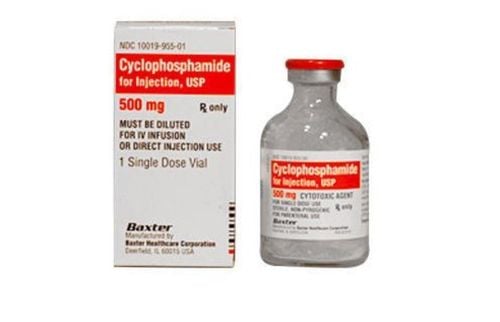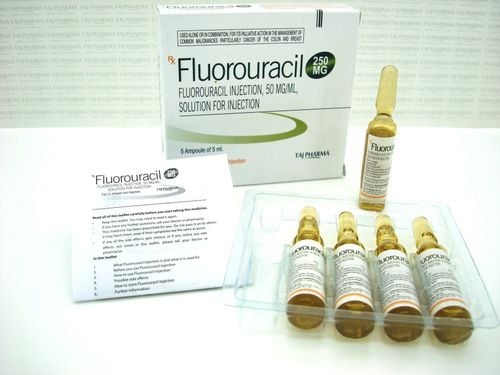This is an automatically translated article.
Article written by Pharmacist Nguyen Le Trang - Clinical Pharmacist - Faculty of Pharmacy - Vinmec Times City International Hospital
Doxorubicin is a drug used in the treatment of cancer, knowing the information about doxorubicin 50 mg or other bulk solutions will help the drug use become more effective and safer for patients.
1. Learn about the drug Doxorubicin
Doxorubicin is prepared as a solution of 50 mg/25 ml, 10 mg/5 ml. Anthracycline cancer treatment drugs, cytotoxic drugs.
Doxorubicin is indicated in the treatment of breast, ovarian and gastric cancer, Hodgkin's or non-Hodgkin's lymphoma, bladder cancer, acute leukemia, multiple myeloma, Wilms' tumor, soft tissue sarcoma and skeletal.
The drug is contraindicated for bone marrow suppression or anthracycline-induced heart failure. Previously treated up to maximum cumulative doses of doxorubicin or other anthracyclines.
With caution in previous chest radiotherapy, liver failure, hyperbilirubinemia, people over 60 years old or children under 4 years old, liver failure.
2. Possible side effects when taking Doxorubicin
Undesirable but common effects when using the main drug are: Erythema, pruritus, infusion reactions, bone marrow suppression, vomiting and nausea, oral mucosal ulcers, esophagitis, diarrhea, hair loss , phlebitis, thrombophlebitis.
Undesirable effects but less common are: Hand-foot syndrome, skin and hair pigmentation changes, nail formation disorders, increased liver enzymes, increased bilirubin.
Rarely are hypersensitivity reactions (urticaria, anaphylaxis), inflammation of the area previously treated with radiation. Note that bone marrow suppression usually causes strong leukopenia, the lowest decrease after 10 days and recovery after 21 days. Platelets and red blood cells decreased slightly. Cardiotoxicity can be acute, chronic, or late. Acute is an electrocardiogram change, arrhythmia, that occurs during or shortly after drug infusion. Toxicity is not dose dependent, usually transient but may cause heart failure and myocarditis.
Chronic heart failure, cardiomyopathy usually occurs within 1 year after treatment, related to the total dose. Late toxicity is left ventricular dysfunction, heart failure, inotropic or arrhythmia. Usually occurs many years after treatment. Local erythematous infusion reaction along the vein, flushed face if injected rapidly.

3. Dosage of Doxorubicin
Dosage, how to use depends on each regimen and the patient's condition. Reference dose:
Adults: Common AC regimen 60 mg/m2 on day 1 every 21 days for 4 cycles (in combination with cyclophosphamide).
Children: 60 - 75 mg/m2 every 21 days (alone regimen) or 40 - 75 mg/m2 every 21 - 28 days (combination regimen).
How to use:
Inject slowly intravenously over at least 3-5 minutes. Intravenous infusion: Dilute in 0.9% NaCl or 5% glucose, intravenous infusion continuously for 24 hours. Change infusion between doxorubicin infusion cycles. Patients at risk of cardiotoxicity should receive continuous intravenous infusion. Bladder pump: Dilute in 25 - 50 ml of 0.9% NaCl. Keep the medicine in the bladder for 1 hour, changing positions every 15 minutes to ensure even contact with the bladder. Prophylaxis of hyperuricemia due to tumor lysis syndrome: Infusion, alkalinization of urine, prophylaxis with allopurinol. Prophylaxis: Dexamethasone 8 mg IV 30 minutes before infusion. Stability: the diluted solution is stable for 28 days at 2 - 8oC. Notes on use / advice: Urine may turn red after 1-2 days of taking the drug. Monitor blood count, liver and kidney function, uric acid, electrolytes. Monitor ECG and left ventricular ejection fraction before and after treatment, frequency of monitoring depends on dose and pre-existing risk factors in the patient.
Pregnant women: D (TGA), D (FDA). Breastfeeding women, avoid taking the drug.
No dose adjustment is required in patients with renal impairment. The dose should be adjusted in patients with hepatic impairment according to bilirubin concentration.
Knowing the information about the drug Doxorubicin will help patients use the right dose and recognize unwanted reactions when taking the drug.
If you need more specific advice on drug use, patients should actively contact the treating doctor or pharmacist for appropriate indications.
Please dial HOTLINE for more information or register for an appointment HERE. Download MyVinmec app to make appointments faster and to manage your bookings easily.














